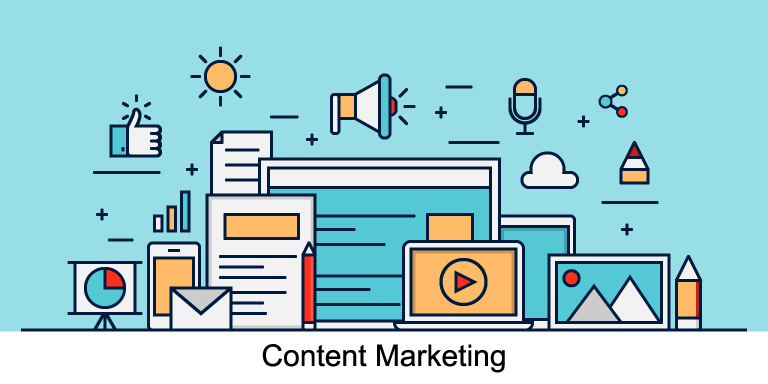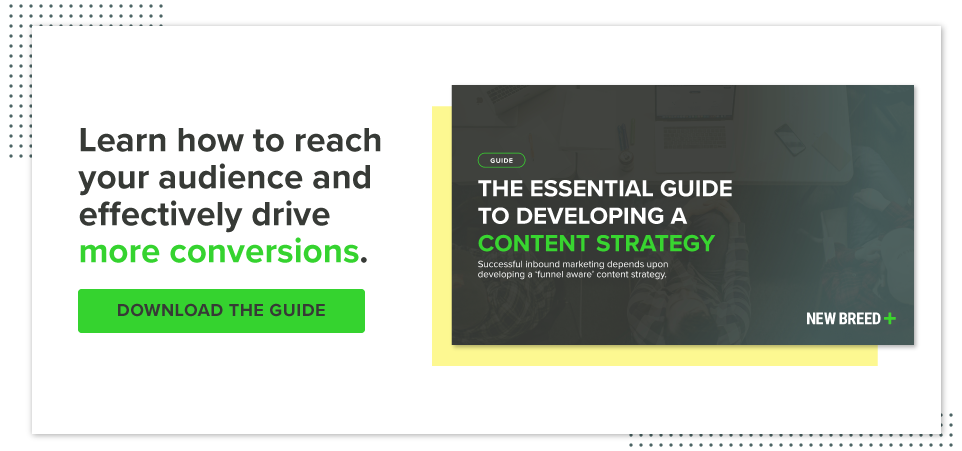
Content marketing is growing more and more important, especially in the B2B marketplace. The buyer is moving online to make their decisions, and there is increasing competition to capture buyers’ time and attention.
As marketers, we need to adapt our tactics to capitalize on this change and meet buyers online. Fortunately, the intersection of SEO, social media and content provides that opportunity, and we can leverage these tools to help guide the buyer through their buying cycle.
Content can be used to educate your prospects and guide them through the stages of their buyer’s journey. In order to effectively leverage content marketing, you need to be sure you’re producing content for the right people. Your buyer personas will inform this process, and as your buyer personas are being revisited, the content you’re producing should be too.
What Is Content?
In short, content is the communicative material that you and your company produce to drive traffic and build relationships with your prospects and customers. The goal of your content should be to further your reach and engage with prospects and current customers in the spaces, both on and offline, that they live.
Defining what could be considered as content is a little tricky. While a blog post (like this one!) can clearly be seen as content, something like a social media post or email campaign tends to blur the lines. They both offer the opportunity for a prospect to have an individualized experience within their respective channels and can be leveraged to increase lead generation, but the experiences they offer are usually limited to just one channel.
While they can intersect with other ongoing campaigns (ie; thematic posts/emails), they lack the flexibility that other pieces of content have. A blog post on the other hand, can usually be leveraged across a number of channels — it can be promoted in an email campaign, featured on a social media platform such as LinkedIn and provide value as a standalone asset of your website.
To best understand what this means, let’s explore how content plays a role in each segment of the buyer’s journey.
The Attract Stage
During the attract stage, you often need to make your prospects aware of a challenge or pain point that they aren’t cognizant of. Once you’ve brought a pain point to their attention, you need to educate them on what that challenge means for them and how your value proposition fits in.
If someone isn’t aware of a pain point to begin with, then you need to put out content where they already live online since they won’t be actively searching for solutions. This could be through display ads, targeted ads and sponsored posts to name a few.
Your content, at this stage, should be able to provide the “A-ha” moment a prospect needs in order to drive them to your website. It’s a bit like going grocery shopping on an empty stomach: You won’t realize how hungry you are until you walk past the snack aisle.
In B2B marketing, the buyer needs to see how your product or service solves their problem and will provide a return on their investment. Your blog, website and social media sites are great platforms to help distribute this content. The content produced will also help to provide strong search rankings and boost your credibility.
The Engage Stage
Once you get your prospects on your website, you need to find a way to engage with them and customize their journey on your webpages. In order to do this, you need to have places for a prospect to convert on your website — every piece of content should have a next step, like a form, that will get them to exchange information with you. For example, at the end of a blog post, you could include a CTA that leads to a gated piece of content.
In addition to providing conversion points on your website, implementing the use of smart content will aid in the creation of a unique website experience. You need to make it as easy as possible for someone to find the content that they’re looking for in that moment, and smart content will help filter that for you. By using a piece of information a prospect has already provided on a previous website visit, smart content will tailor the user experience and show them a new piece of content they haven’t interacted with yet.
Through email nurture campaigns, newsletters and conversational marketing strategies, you can continue engaging with and providing a prospect with a myriad of conversion points that align with their interests and deliver your value proposition. Eventually, a prospect will get to the point where their engagement involves sales which can become a 1-on-1 type of communication that will lead them into the delight stage.
The Delight Stage
Once you’ve transitioned your prospects into the delight stage, you need to begin to deliver on the expectations that you set to begin with.
Providing quality content is important for the overall customer experience. Thought leadership in the form of press releases, knowledge base articles or blog posts can help continue to educate your customers about your organization once they’ve closed. That way, your customers can stay informed about advances in your product and services.
For example, if the majority of your customer base lives on HubSpot, releasing content that walks a reader through the platform will not only continue to educate them but also reassure them of their decision to close with you. No customer is going to want to close a deal with a company that forgets about them once they’ve been handed off to services — the right content can help make that transition feel seamless.
Publishing content like newsletters, webinars and articles on your website and other channels are all great ways to strengthen the relationship between your brand and the customer. Engage your current customer base through social media sites or video content to deepen the relationship. If nurtured properly, these customers can be great advocates for your organization.
Key Takeaway
Content plays a huge part in every segment of the buyer’s journey. It is much more than just a way to attract leads — if approached correctly and in a holistic manner, content can provide much more return for your organization.
This post was selected as one of the top digital marketing articles of the week by UpCity, a B2B ratings and review company for digital marketing agencies and other marketing service providers.





